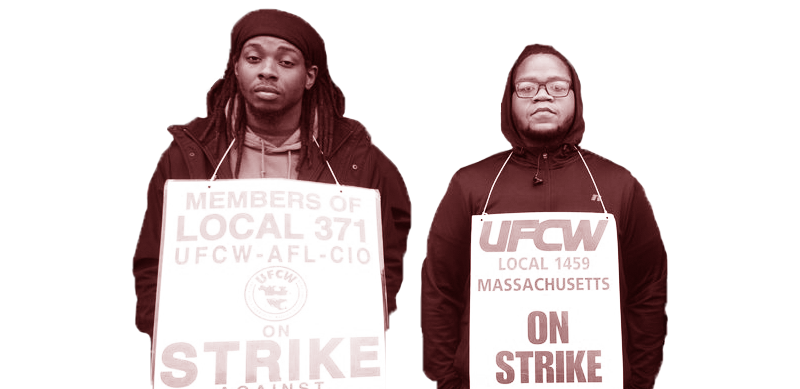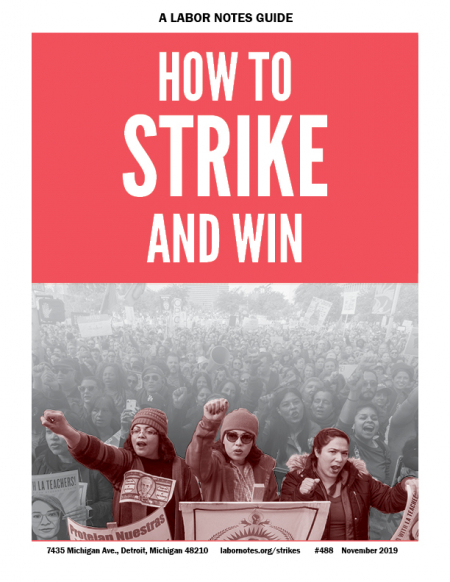How Strikes Win

The best organizing in the world may fail to move your employer if you don't start with a solid plan to win. Photo: UFCW 1459.
Assess all the types of leverage the union can bring to bear: how will you make the employer cry uncle?
How to Strike and Win
A Labor Notes Guide
labornotes.org/strikes
The Big Picture
Know Your ABC's
Building Blocks
- Turn Up the Heat
- Organize the Organized
- Democracy: Who Owns the Strike?
- Community: Who Else Owns It?
- How to End a Strike
At a Glance
A good strike is an exercise of power, not just a rowdier form of protest. There is something you want, and a decision-maker who could give it to you but doesn’t want to. The point of the strike is to make it harder for this decision-maker to keep saying no—and easier for the decision-maker to stop the pain by saying yes.
For a private-sector employer, the primary way a strike exerts power is by hurting profits.
For a public-sector employer, it is by interfering with the normal functions of public service and creating a political crisis that elites must respond to.
It’s essential to carefully appraise all the forms of power, or leverage, the union can muster. Don’t hit the bricks without assessing what it will take to win.
Once your leverage is identified, you’ll have to do the organizing legwork to make it real. Leverage is only potential until you bring it to life. The union will rely on its own internal solidarity to remain united in the face of intimidation and to generate widespread solidarity from others. The advice in the rest of this manual is designed to build that internal and external solidarity.
But the best organizing in the world may fail to move your employer if you don’t start with a solid plan to win. That’s an analysis of how the actions by workers and supporters will add up to enough pressure to make the decision-maker back down.
ANALYZE YOUR LEVERAGE
To hurt profits, the union must stop the production or distribution of goods or services. You will need to make sure that union members have withdrawn their labor—and that no one else is doing the work either.
Standing earnestly on the picket line may not be enough. Verizon strikers in 2016 used roving pickets (see here). How about seriously blocking the entrances? How about interrupting recruitment of replacements? How about preventing the delivery of parts or supplies? How about stopping the employer from selling the goods it's made?
Historically unions have used mass picketing, striking suppliers, and even sit-down strikes. They have used solidarity to strike entire industries or to call secondary boycotts of the employer's allies.
Most of these tactics are now outlawed. (See here.) Again, a union that plans illegal action will need to have a firm grasp of the risks and a solid plan.
In the public sector most employers save money during a strike because they keep collecting taxes but don’t pay salaries. Since the strike is not hurting the employer financially, the leverage is different. The strike has to be one component of a mobilization that brings unbearable political pressure on decision-makers.
PUBLIC OPINION ON BOARD
In either a public or a private sector strike, you will need a plan to get public opinion on board and to get your allies to take strong action. (See here.) In a teacher strike, for example, getting the parents on your side is crucial—the inconvenience to them is what generates the political crisis you need, but only if they blame the district and not the union. Your leverage might also include hitting the district’s bottom line; is there a state funding formula based on how many students show up each day? In a retail strike, your leverage is the sales your employer is losing—which depend on your strong picket lines and customers’ unwillingness to cross them.
Look for other pressure points on your employer, such as its relations with suppliers, customers, and public officials, and enforcement of government regulations it may be violating or tax breaks it is seeking.
Kaiser mental health clinicians in California have waged repeated strikes demanding shorter wait times for patients and a fix for chronic understaffing. Their union published a white paper showing how Kaiser was violating California law and filed claims with state agencies, which eventually got Kaiser fined $4 million. At the same time the company faced class-action lawsuits from families of patients who died by suicide after not receiving timely care.
TAKE THE MEASURE OF YOUR OPPONENT
The union needs to take a hard look at its place in the employer’s overall business and to use smart tactics that exploit the union’s advantages.
Because of their small numbers, workers at seven Verizon Wireless retail stores in Brooklyn and Massachusetts would have been out on a limb if they had struck on their own. But they leaned on 39,000 fellow Communications Workers in the company’s landline sector, who struck and held out until the wireless workers got a contract too.

SUPPORT LABOR NOTES
BECOME A MONTHLY DONOR
Give $10 a month or more and get our "Fight the Boss, Build the Union" T-shirt.
At the same time, being able to picket the wireless stores gave the landline workers a boost. Though landlines are still profitable, the mostly nonunion wireless side of the business is far more lucrative and has been the focus of the company’s investments in recent years. Pickets outside the wireless stores cut Verizon’s sales in New York City by 40 percent—so both sides of the union were hurting Verizon’s profits, as well as its public image.
What is your employer’s economic situation? If it claims its budget is hurting, what is your response? If it’s part of a larger entity, how much effect will your strike have on overall profits or on operations? Which other parts of the employer are unionized, and do you have relations with those unions?
If your ability to hurt total profits is low, do you have other sources of power to make up for that?
Which decision-makers will you need to scare—local, national, international, government officials? Who exactly has the power to give you what you want? The answer is never simply “the company.” It might be CEO John Smith, who has an office, a neighborhood, a rolodex, and a calendar, and who may belong to X country club or Y congregation.
How vulnerable are customers and suppliers to pressure you can bring? Which banks provide financial backing? What’s the employer’s record on safety, environment, discrimination and harassment?
Answering these questions will take research. Some unions have research departments—bring them in early. But your union probably includes members who already follow and understand the news in your industry, and others with a gift for Googling. Find and enlist your nerds!
FIND YOUR CHOKEPOINTS
The global economy depends on goods flowing seamlessly over oceans and across borders. Factories and retailers no longer store inventory for weeks in big warehouses but count on parts and goods delivered “just in time,” using ships, terminal yards, and trucks as their mobile warehouses.
It’s ironic that employers introduced “just in time,” which boosts profits when it’s working fine, because the tight, no-errors-allowed system gives even small groups of workers enormous power— their strike can bring a much larger system to a halt. This is true for both supplier workers and logistics workers who deliver the parts.
One day in 2014, workers at the Piston Automotive factory in Toledo, Ohio, went on strike for union recognition at 9 a.m.—and by 5 p.m., they'd won. The 70 workers made brake systems and struts for the profitable Jeep Cherokee, built by Chrysler in a plant across town.
Their strike could have quickly shut down Jeep production. Union organizers warned Chrysler managers, who undoubtedly leaned on Piston Automotive to settle.
Is your workplace part of a system that depends on all parts working smoothly together? Do you have relationships with the workers at the most crucial nodes? Chokepoints also exist within workplaces. Which department in your workplace is the “bottleneck”? Are the members there aware of their power? Has the union made a special effort to develop leaders there?
During the organizing drive at the Smithfield Foods pork plant in 2006, the key was the Livestock department, where live hogs were unloaded off trucks. One sweltering morning, the drinking water in Livestock was hot and had ants floating in it. With temperatures nearing 100 degrees, the workers decided not to work until they had clean, cold water.
For eight hours, 25 workers sat in the barn, their arms folded. The whole plant stopped. Trucks full of hogs waited outside. Supervisors tried and failed to run the hogs in by themselves.
The next morning the Livestock workers got their water. Their impromptu sit-down strike was a vivid demonstration of workers’ power—and the organizing drive grew from there.
IT’S IN THE TIMING
Bosses need workers, but they need us some times more than others. A smart union will time its contract expiration for management’s peak season, or it can pull an unfair labor practice strike (see here) at a favorable moment.
For years, transit workers in New York City had a contract that expired in December, when shoppers were jamming the buses and trains. Farmworkers, even without a union, have made gains by laying down their buckets just when the produce is ripe on the vines.
If there is no obvious production season, are there moments that would be embarrassing—say, when a big shot is planned to visit? Workers at the Four Roses bourbon distillery walked out just as their industry was preparing to welcome thousands of tourists to the annual Kentucky Bourbon Festival.
In 2019 the contract for 31,000 Stop & Shop grocery workers in New England expired on February 23. But workers didn’t strike till April 11—just 10 days before Easter. Their action cost the company $345 million.
Fighting for a first contract in 2019, bus drivers in Alexandria, Virginia, took a strike vote just as the region was preparing to shut down most of its commuter rail system for repairs. Thousands of residents who commuted to D.C. every day would be relying on bus service all summer—unless the drivers went on strike.
Drivers educated the riding public by handing out flyers at transit hubs. “When the pressure started coming from the community on the mayor and on [management], they knew we had them,” said driver Tyler Boos. Workers won complete wage parity with drivers in other Northern Virginia cities—on the strength of their strike vote.





